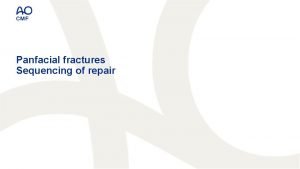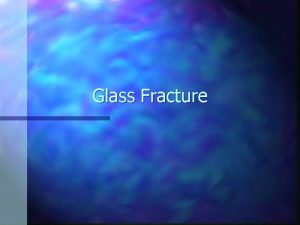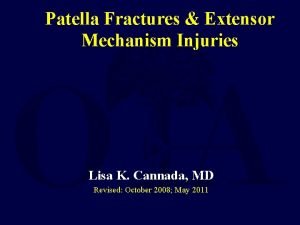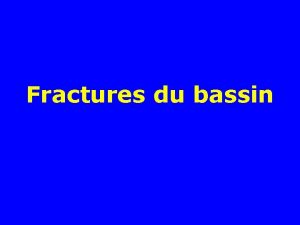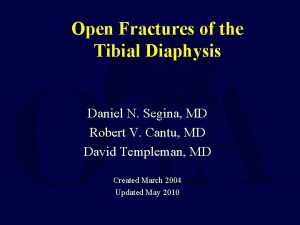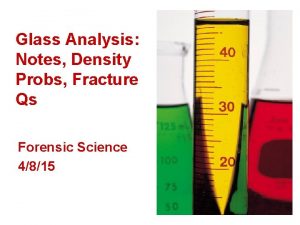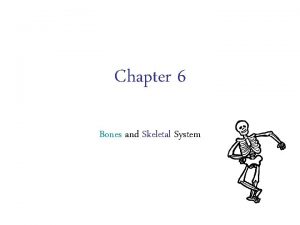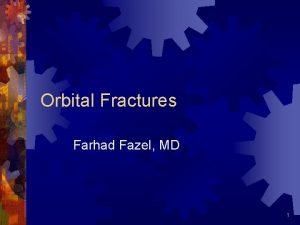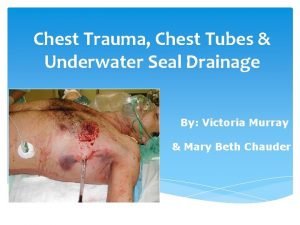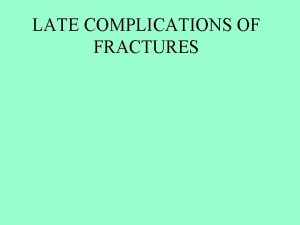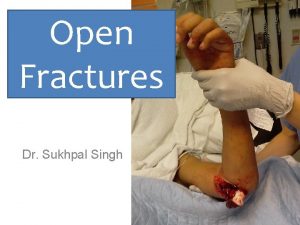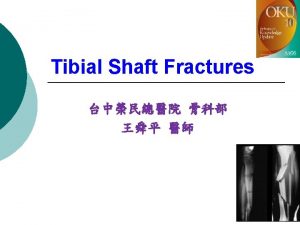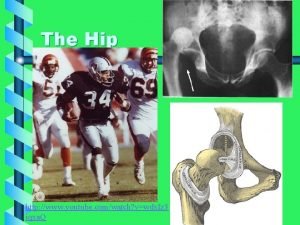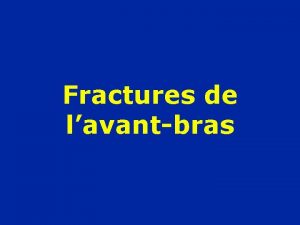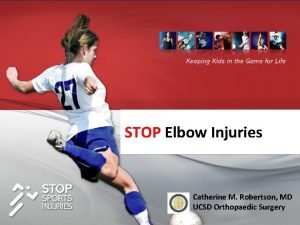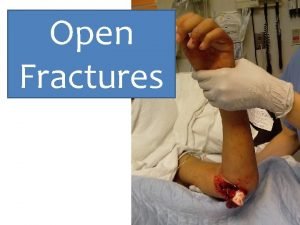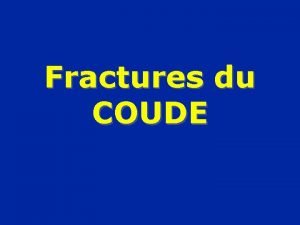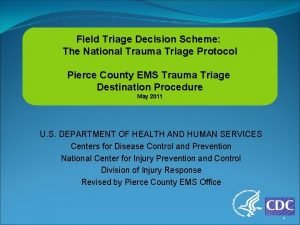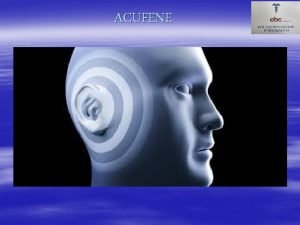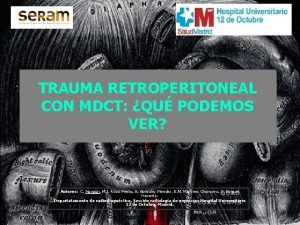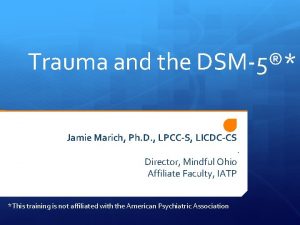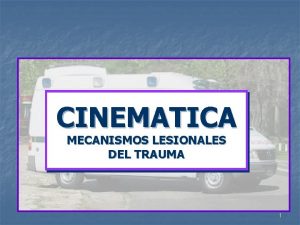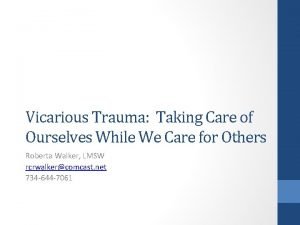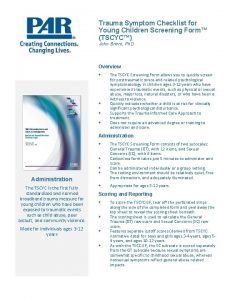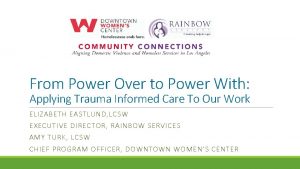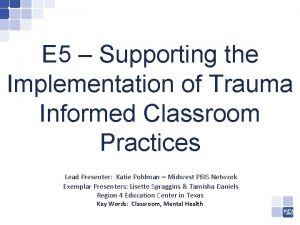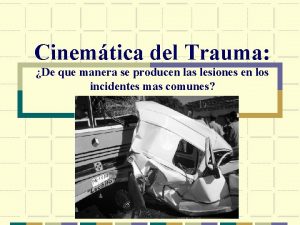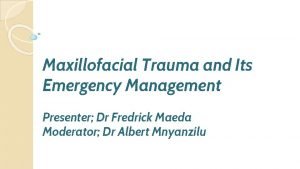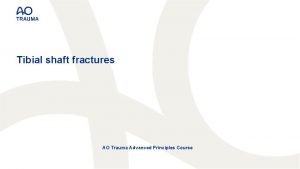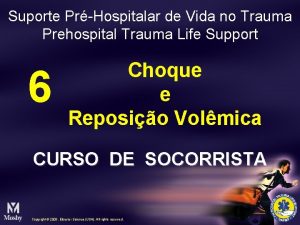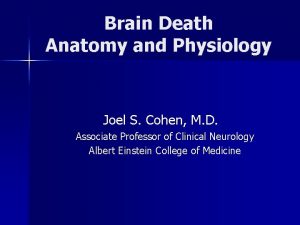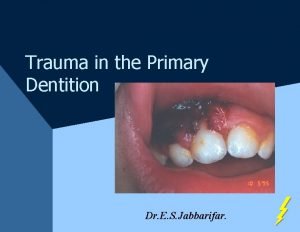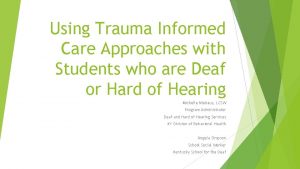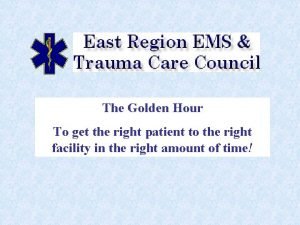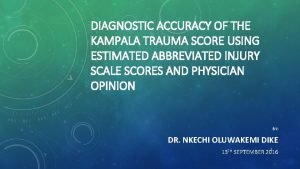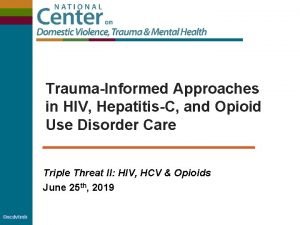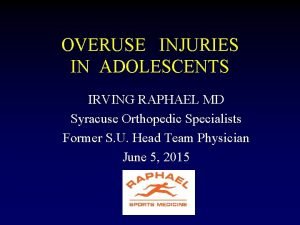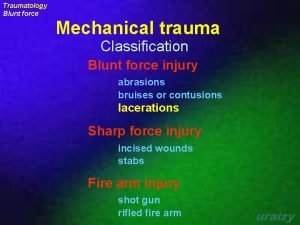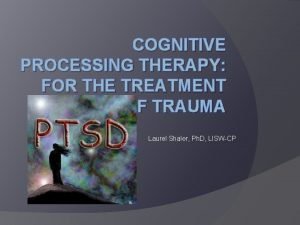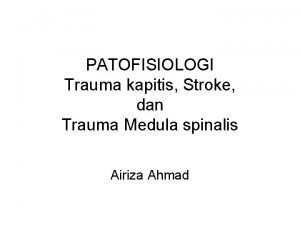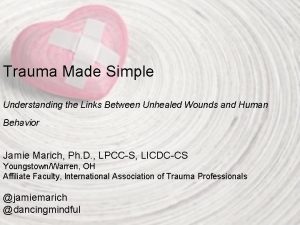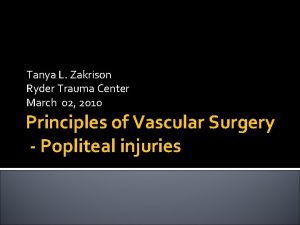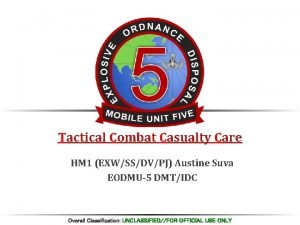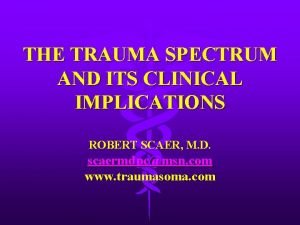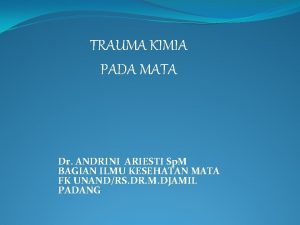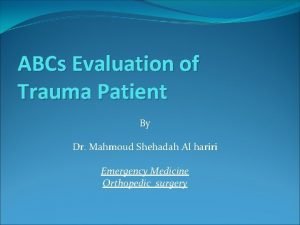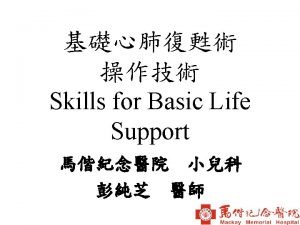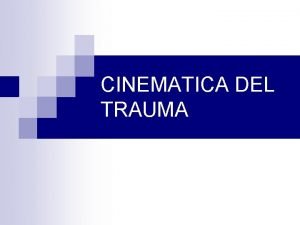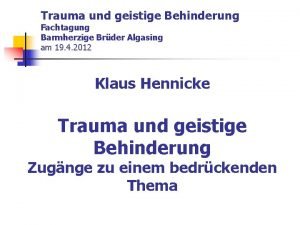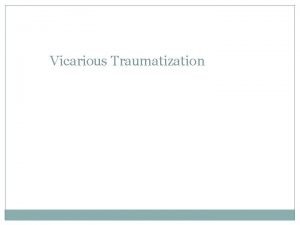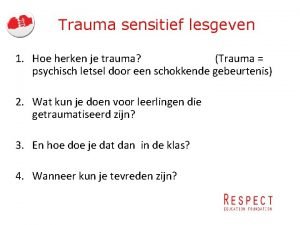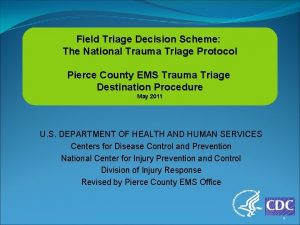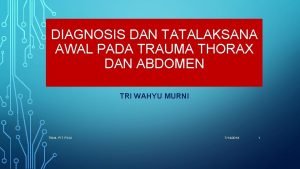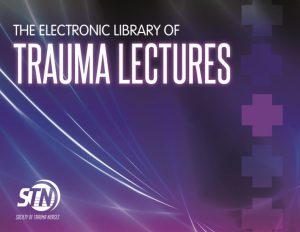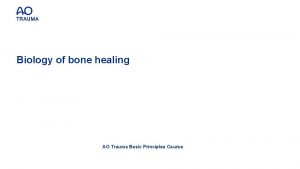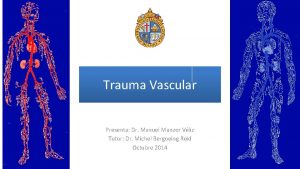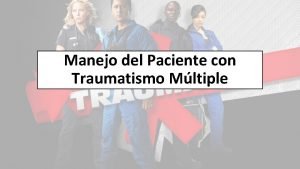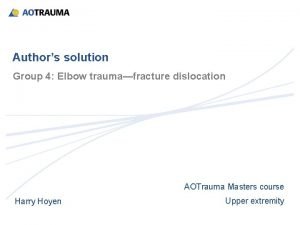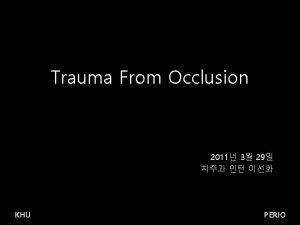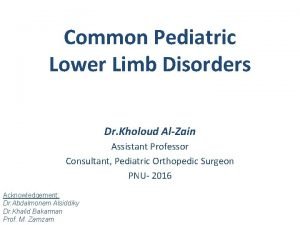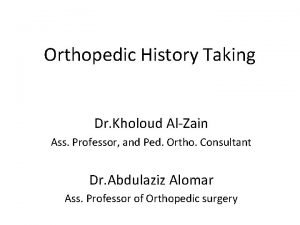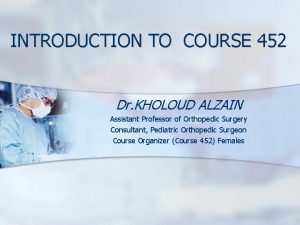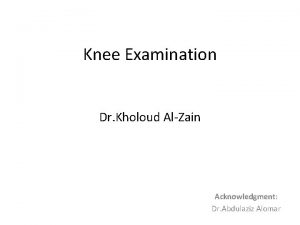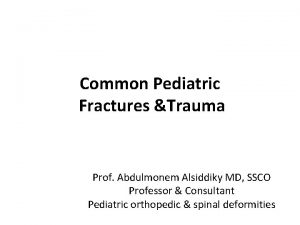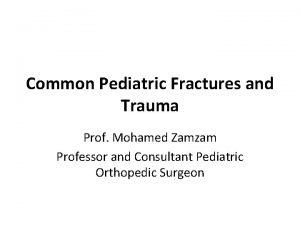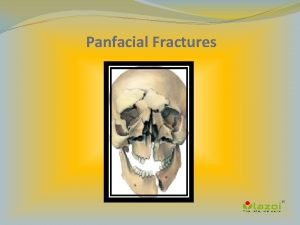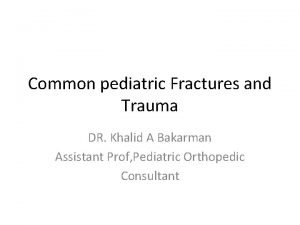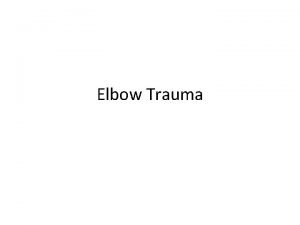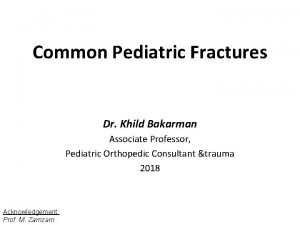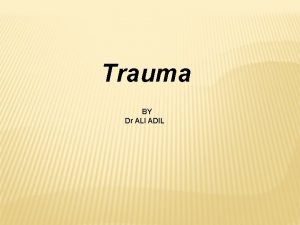Common Pediatric Fractures Trauma Dr Kholoud AlZain Prof




































































































- Slides: 100

Common Pediatric Fractures & Trauma Dr. Kholoud Al-Zain Prof. Zamzam Ass. Professor and Consultant Pediatric Orthopedic Surgeon Dec 2017

Objectives • • • Introduction Difference between Ped & adult Physis # Salter-Harris classification Indications of operative treatment Methods of treatment of Ped # & trauma Common Ped #: – U. L clavicle, humeral supracondylar, distal radius – L. L femur shaft • Example

Pediatric Fractures

Introduction • • Fractures account for ~15% of all injuries in children Boys > girls Rate increases with age Type of fractures vary in various age groups (infants, children, adolescents ) Mizulta, 1987

Difference Between A Child & Adult’s Fractures

Why are Children’s Fractures Different ? • Growth plate: – Perfect remodeling power – Injury of growth plate may cause: • Angular deformity • Or leg length inequality (L. L. I)

Why are Children’s Fractures Different ? • Bone: – Increased (collagen: bone) ratio • Less brittle • Deformation

Why are Children’s Fractures Different ? • Cartilage: – Difficult X-ray evaluation – Size of articular fragment often under-estimated

Why are Children’s Fractures Different ? • Periosteum: – Metabolically active • More callus, rapid union, increased remodeling – Thickness and strength • May aid reduction

Why are Children’s Fractures Different ? • Ligaments: – Functionally stronger than bone. – Higher proportion of injuries that produce sprains in adults result in fractures in children.

Why are Children’s Fractures Different ? • Age related fracture pattern: – Infants diaphyseal # – Children metaphyseal # – Adolescents epiphyseal

Why are Children’s Fractures Different ? • Physiology – Better blood supply rare delayed and non-union

Remodeling



Physis Fractures

Physis Injuries • • • Account for ~25% of all children’s # More in boys More in upper limb Most heal well rapidly with good remodeling Growth may be affected

Physis Injuries- Classifications Salter-Harris

Salter-Harris Classification

Salter-Harris Classification

Physis Injuries- Complications • Physeal bridging < 1% • Cause affecting growth (varus, valgus, or even L. L. I) • Keep in mind: – Small bridges (<10%) may lyse spontaneously – Central bridges more likely to lyse – Peripheral bridges more likely to cause deformity

Physis Injuries- Complications • Take care with: – Avoid injury to physis during fixation – Monitor growth over a long period (18 -24 m) – When suspecting physeal bar do MRI

Indications of Operative Treatment

General Management Indications for surgery • • • Open fractures Severe soft-tissue injury Fractures with vascular injury Compartment syndrome Multiple injuries Displaced intra articular fractures (Salter-Harris III-IV ) Failure of conservative means (irreducible or unstable #’s) Malunion and delayed union Adolescence Head injury Neurological disorder Uncooperative patient

Methods of Treatment of Pediatric Fractures & Trauma

1) Casting still the commonest

1) Casting still the commonest

2) K-wires • Most commonly used internal fixation (I. F) • Usually used in metaphyseal fractures

3) Intramedullary wires (Elastic nails)

4) Screws

5) Plates specially in multiple trauma

6) I. M. N only in adolescents (>12 y)

7) Ex-fix usually in open #

Methods of Fixation Co a n i mb n o i t

Common Pediatric Fractures

Common Pediatric Fractures • Upper limb: – Clavicle – Humeral supracondylar – Distal radius • Lower Limbs: – Femur shaft (diaphysis)

Clavicle Fractures

Clavicle # - Incidents • • • 8 -15% of all pediatric # 0. 5% of normal SVD 1. 6% of breech deliveries 90% of obstetric # The periosteal sleeve always remains in the anatomic position (remodeling is ensured)

Clavicle # - Mechanism Injury • Indirect fall onto an outstretched hand • Direct: – The most common mechanism – Has highest incidence of injury to the underlying: • N. V &, • Pulmonary structures • Birth injury

Clavicle # - Examination • Look Ecchymosis • Feel: – Tender # site – As a palpable mass along the clavicle (as in displaced #) – Crepitus (when lung is compromised) • Special tests Must assesse for any: – N. V injury – Pulmonary injury

Clavicle # - Reading XR • Location: – (medial, middle, lateral) ⅓ commonest middle ⅓ – Commonest # site middle/lateral ⅓ • Open or closed see air on XR • Displacement % • Fracture type

Clavicle # - Treatment • Newborn (< 28 days): – No orthotics – Unite in 1 w • 1 m – 2 y: – Figure-of-eight – For 2 w • 2 – 12 y: – Figure-of-eight or sling – For 2 -4 weeks

Clavicle # - Remodeling

Clavicle # - Treatment Indications of operative treatment: • Open #’s, or • Neurovascular compromise

Clavicle # - Complications (rare) • From the #: – Malunion – Nonunion – Secondary from healing: • Neurovascular compromise • Pulmonary injury • In the wound: – Bad healed scar – Dehiscence – Infection

Humeral Supracondylar Fractures

Supracondylar #- Incidences • • 55 -75% of all elbow # M: F 3: 2 Age 5 - 8 years Left (non-dominant) side most frequently #

Supracondylar #- Mechanism of Injury • Indirect: – Extension type – >95% • Direct: – Flexion type – < 3%

Supracondylar #- Clinical Evaluation • Look: – Swollen – S-shaped angulation – Pucker sign (dimpling of the skin anteriorly) – May have burses • Feel: – Tender elbow • Move: – Painful & can’t really move it • Neurovascular examination

Supracondylar #- Gartland Classification Type-III Complete displacement (extension type) may be: • Posteromedial (75%), or • Posterolateral (25%)

Supracondylar #- Gartland Classification Type-III Complete displacement (extension type) may be: • Posteromedial (75%), or • Posterolateral (25%)

Supracondylar #- Gartland Classification

Normal XR Lines • • Anterior Humeral Line Hour-glass appearance Fat-pad sign Radio-capitellar line

Type 1 • • Anterior Humeral Line Hour-glass appearance Fat-pad sign Radio-capitellar line

Type 2

Type 3

Supracondylar #- Treatment • Type-I: – Above elbow cast (or splint) – For 2 -3 weeks • Type-II: – Closed reduction & above elbow casting, or – Closed reduction with percutaneous pinning (if: unstable or sever swelling), & above elbow cast (splint) – For 4 -6 weeks • Type III: – Attempt closed reduction & percutaneous pinning – If fails open reduction & pinning (ORIF) – For 4 -6 weeks – Direct ORIF if open #

Supracondylar #- Treatment

Supracondylar #- Treatment

Supracondylar #- Complications • Neurologic injury (7% to 10%): – Median and anterior interosseous nerves (most common) – Most are neurapraxias – Requiring no treatment • Vascular injury (0. 5%): – Direct injury to the brachial artery, or – Secondary to swelling (compartment syndrome)

Supracondylar #- Complications • • Loss of motion (stiffness) Myositis ossificans Angular deformity (cubitus varus) Compartment syndrome

Supracondylar #- Flexion Type 3

Distal Radial Fractures (Metaphysis)

Classification • Depending on pattern: – Torus (buckle) only one cortex is involved – Incomplete (greenstick) – Complete

Distal Radius Metaphyseal Injuries Torus (buckle) fracture: • Are stable • Immobilized for pain relief in below elbow cast, 2 -3 weeks

Distal Radius Metaphyseal Injuries Torus (buckle) fracture:

Distal Radius Metaphyseal Injuries Incomplete (greenstick): • Greater ability to remodel (why ? ) • Closed reduction and above elbow cast

Distal Radius Metaphyseal Injuries Complete fracture: • Closed reduction, then well molded above elbow cast for 6 -8 w • Or open reduction and fixation (internal or external)

Distal Radius Metaphyseal Injuries Complete fracture: • Closed reduction, then well molded above elbow cast for 6 -8 w

Distal Radius Metaphyseal Injuries Complete fracture: • Or open reduction and fixation (internal or external)

Distal Radius Metaphyseal Injuries Complete fracture: Indications for ORIF: • Irreducible fracture • Open fracture • Compartment syndrome

Distal Radius Meta. Injuries- Complications • Malunion Residual angulation may result in loss of forearm rotation • Nonunion Rare • Refracture With early return to activity (before 6 w) • Growth disturbance Overgrowth or undergrowth • Neurovascular injuries With extreme positions of immobilization

Examples of Distal Radial Fractures

Distal Radial Fractures Physeal Injuries

Distal Radial Physeal #- “S. H” Type I

Distal Radial Physeal #- “S. H” Type II

Distal Radial Physeal #- “S. H” Type III

Distal Radial Physeal #- Treatment Types I & II • Closed reduction followed by above elbow cast • We can accept deformity: – 50% translation – With no angulation or rotation • Growth arrest can occur in 25% with repeated closed reduction manipulations • Open reduction is indicated in: – Irreducible # – Open #

Distal Radial Physeal #- Treatment Types II AP Lat

Distal Radial Physeal #- Treatment Types II

Distal Radial Physeal #- Types III

Distal Radial Physeal #- Treatment Types III • Anatomic reduction necessary intra-articular • ORIF with smooth pins or screws

Distal Radial Physeal #- Treatment Types IV & V • Rare injuries • Need ORIF

Distal Radial Physeal #- Complications • Physeal arrest – Shortening – Angular deformity • Ulnar styloid nonunion • Carpal tunnel syndrome

Femoral Shaft Fractures

Femoral Shaft # • 1. 6% of all pediatric # • M>F • Age: – (2 – 4) years old – Mid-adolescence • Adolescence >90% due to RTA

Femoral Shaft #- Mechanism of Injury • Direct trauma: – RTA, – Fall, or • Indirect trauma: – Rotational injury • Pathologic #: – Osteogenesis imperfecta – Nonossifying fibroma – Bone cysts – Tumors

Femoral Shaft #- Clinical Evaluation • Look: – – – Pain, Swelling of the thigh, Inability to ambulate, and Variable gross deformity Careful O/E of the overlying soft tissues to rule out the possibility of an open fracture (puncture wound) • Feel: – Tender # site • Careful neurovascular examination is essential

Femoral Shaft #- Treatment < 6 m: • Pavlik Harness • Closed reduction & immediate hip spica casting • Or traction 1 -2 w, then hip spica casting

Femoral Shaft #- Treatment 6 m – 6 y: • Closed reduction & immediate hip spica casting (>95%) • Or traction 1 -2 w, then hip spica casting

Femoral Shaft #- Treatment 6 – 12 y: • Flexible I. M. N • Bridge Plating • External Fixation

Femoral Shaft #- Treatment 6 – 12 y: • Flexible IMN • Bridge Plating • External Fixation

Femoral Shaft #- Treatment 6 – 12 y: • Flexible IMN • Bridge Plating • External Fixation: – Multiple injuries – Open fracture – Comminuted # – Unstable patient

Femoral Shaft #- Treatment 12 y to skeletal maturity: • Intramedullary fixation with either: – Flexible nails, or – Locked I. M nail

Femoral Shaft #- Treatment Operative Indications: • • • Multiple trauma, including head injury Open fracture Vascular injury Pathologic fracture Uncooperative patient

Femoral Shaft #- Complications • Malunion – Remodeling will not correct rotational deformities • Leg length discrepancy – Secondary to shortening or overgrowth • Muscle weakness • Nonunion (rare)

Any Questions?

Remember …

Remember • Pediatric fractures have great remodeling potentials • The importance of growth plates & periosteum in remodeling • A good number of cases can be treated conservatively • Operative fixations aids in avoiding complications

Objectives • Difference between adult & pediatric # • Growth plate # Salter-Harris classification, treatments, & complications • Methods of treatment of pediatric # & there indications • Know the common pediatric #: mechanism of injury, evaluations (clinical & radiological), treatments, and complications
 Common pediatric medications
Common pediatric medications Panfacial fractures sequencing
Panfacial fractures sequencing Danis and weber classification
Danis and weber classification Concentric fracture in glass
Concentric fracture in glass Types of fractures with pictures
Types of fractures with pictures Fracture bassin classification
Fracture bassin classification Types of glass fractures
Types of glass fractures Daniel tibia
Daniel tibia Radial lines glass
Radial lines glass Types of fractures with pictures
Types of fractures with pictures Types of fractures with pictures
Types of fractures with pictures Water seal chest tube
Water seal chest tube Late complication of fracture
Late complication of fracture Dr sukhpal singh
Dr sukhpal singh Gustilo anderson classification antibiotics
Gustilo anderson classification antibiotics Acetabular fractures
Acetabular fractures Bone cancer fractures
Bone cancer fractures Pronation main
Pronation main Irving olecranon fractures
Irving olecranon fractures Open fracture treatment
Open fracture treatment Classification des fractures supracondyliennes
Classification des fractures supracondyliennes Acetabulum ossification
Acetabulum ossification Factors of 54
Factors of 54 What is the greatest common factor of 18, 36, and 90?
What is the greatest common factor of 18, 36, and 90? Lcm of 10 and 18
Lcm of 10 and 18 Common anode and common cathode
Common anode and common cathode Highest common factors and lowest common multiples
Highest common factors and lowest common multiples Factor tree of 48
Factor tree of 48 Field triage decision scheme
Field triage decision scheme Inophthalmos
Inophthalmos Trauma-informed questions for clients
Trauma-informed questions for clients Trauma acustico terapia
Trauma acustico terapia Trauma vascular
Trauma vascular 4 r's trauma informed care
4 r's trauma informed care Examples of little t trauma
Examples of little t trauma Trauma informed care for foster youth
Trauma informed care for foster youth Trauma recovery and empowerment model
Trauma recovery and empowerment model Https://www.youtube.com/
Https://www.youtube.com/ Cavitacion en trauma
Cavitacion en trauma Vicarious felidae
Vicarious felidae Trauma symptom checklist for young children
Trauma symptom checklist for young children Power to resist trauma
Power to resist trauma Isi pikir
Isi pikir Trauma informed physical environment
Trauma informed physical environment Tipos de contusiones
Tipos de contusiones Cinematica del trauma
Cinematica del trauma Types of physical trauma
Types of physical trauma Emergency management of maxillofacial trauma
Emergency management of maxillofacial trauma Tibial shaft fracture ao
Tibial shaft fracture ao Stan and ute lawrence
Stan and ute lawrence Pasg trauma
Pasg trauma Trauma vicario definición
Trauma vicario definición Facial trauma
Facial trauma Dental trauma
Dental trauma Trauma dumping examples
Trauma dumping examples Golden hour of trauma
Golden hour of trauma Kampala trauma score
Kampala trauma score Gabriela zapata alma
Gabriela zapata alma Lgbtq trauma informed care
Lgbtq trauma informed care Labelling
Labelling Shoulder trauma irving
Shoulder trauma irving Chapter 24 trauma overview
Chapter 24 trauma overview Budowa mózgu
Budowa mózgu Triple trauma paradigm
Triple trauma paradigm Trauma
Trauma Trauma first aid
Trauma first aid Trauma impact statement worksheet
Trauma impact statement worksheet A b c d trauma
A b c d trauma Patofisiologi trauma medula spinalis
Patofisiologi trauma medula spinalis Trauma made simple
Trauma made simple Limbic system and trauma
Limbic system and trauma Ryder trauma center
Ryder trauma center March trauma
March trauma Emicostato definizione
Emicostato definizione Trauma bonding definition
Trauma bonding definition Robert scaer
Robert scaer Trauma informed peer support
Trauma informed peer support Helene dellucci trauma
Helene dellucci trauma Derajat trauma kimia mata
Derajat trauma kimia mata Revised trauma score
Revised trauma score What is perhaps
What is perhaps Uccs health center
Uccs health center Xabcd trauma
Xabcd trauma Tickles paediatric assessment
Tickles paediatric assessment Dibujo cinematica del trauma
Dibujo cinematica del trauma Trauma gestig behindert
Trauma gestig behindert Traumatization definition
Traumatization definition Trauma sensitief lesgeven
Trauma sensitief lesgeven Childhood trauma discussion questions
Childhood trauma discussion questions Field triage decision scheme steps
Field triage decision scheme steps Jackson's triad orthodontics
Jackson's triad orthodontics Contusion of thorax
Contusion of thorax Conclusion of shock
Conclusion of shock Ao trauma
Ao trauma Toracica alta
Toracica alta Escala abreviada de lesiones
Escala abreviada de lesiones Think trauma
Think trauma Cbits feeling thermometer
Cbits feeling thermometer Triple trauma paradigm
Triple trauma paradigm Head trauma classification
Head trauma classification Trauma from occlusion treatment
Trauma from occlusion treatment

